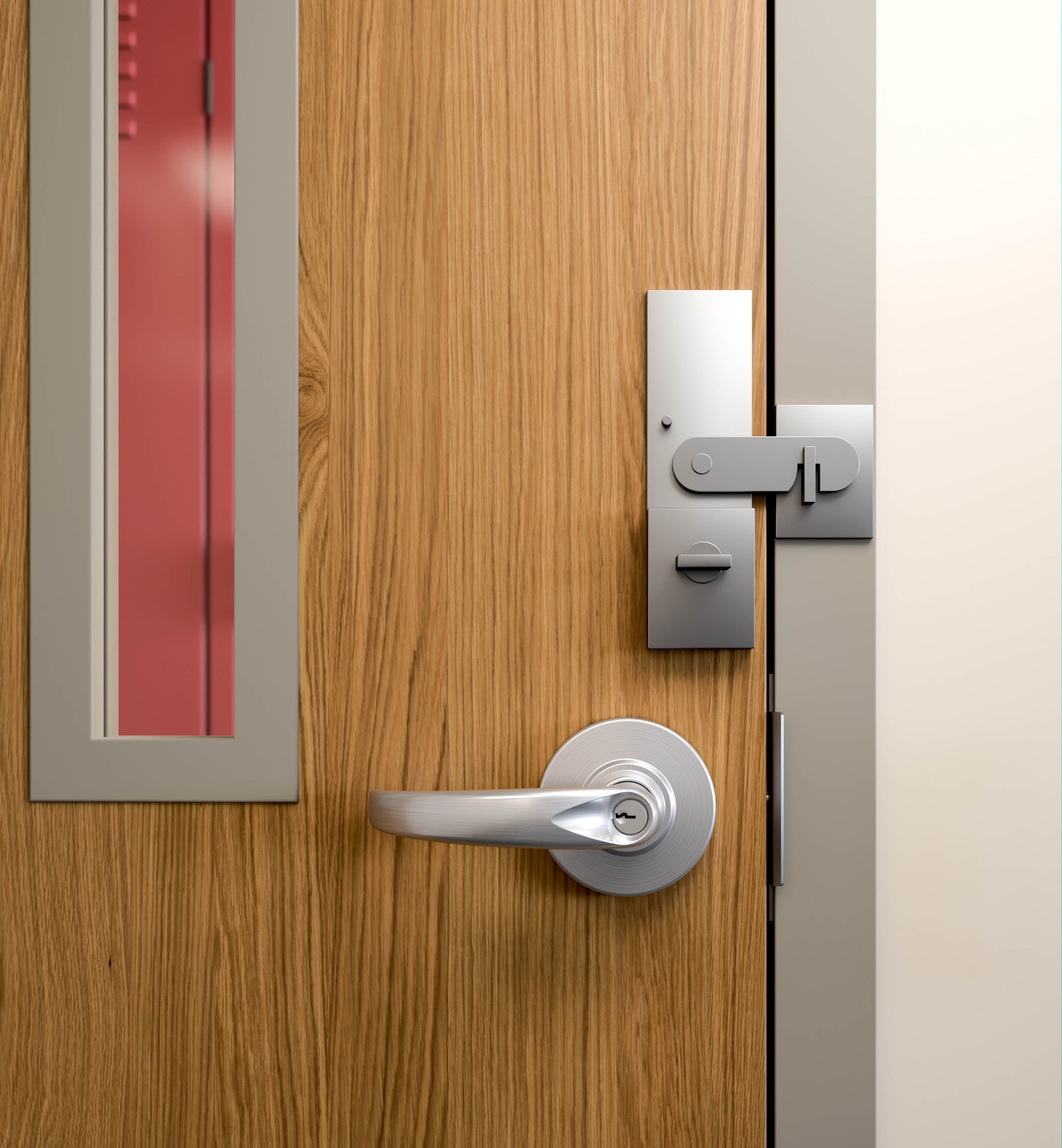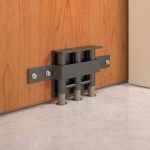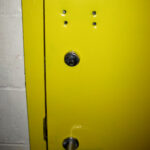This is a long post, but an important one, about a change to NFPA 101, Life Safety Code. I’ve separated it into sections to make it easier for you to read what you need to, and skip what you already know.
~~~
Background
Many of you will remember that in 2017, there was talk of making a change to NFPA 101-2018 regarding the allowable number of releasing operations for egress doors in schools. The change would have allowed classroom doors in existing educational occupancies to have hardware that requires two releasing operations, instead of the one operation to unlatch the door that has been required for decades. To recap what occurred:
- This Decoded article and this guest blog post from Joe Hendry (now with the ALICE Training Institute) outline the concerns associated with two releasing operations.
- At NFPA’s annual meeting, the vast majority of voters opted for a single operation to unlatch the door, but appeals were filed by a barricade device manufacturer.
- Stakeholders submitted their positions on the issue during the appeal process, and the appeals were denied by the NFPA Standards Council. The language allowing two releasing operations was not included in the 2018 edition of NFPA 101.
Through the entire process and in the years since, this quote from the NFPA 101 Technical Committee on Means of Egress stuck with me:
“It is the position of the TC on Means of Egress that increasing the number of latch/lock releasing operations is dangerous and could create a hazard to occupants. Technology exists that will meet the current code requirement for not more than one latch/lock releasing operation. The need for multiple operations is contrary to decades of experience resulting in fatalities in schools and other buildings. Single-action egress is an important aspect of life safety for all emergencies.”
~~~
 TIA 1436
TIA 1436
Earlier this year, a school district in Maryland submitted a TIA to revise the 2018 edition of NFPA 101. A TIA is a Tentative Interim Amendment – a change that may be proposed as a revision to an existing standard, to address a problem that is of an emergency nature. TIA 1436 proposed the addition of a line of text in the section addressing classroom doors in existing schools: “(3) Two non-simultaneous releasing operations shall be permitted.“
Despite opposition to the change and an appeal from the Builders Hardware Manufacturers Association (BHMA), and testimony from the Massachusetts State Fire Marshal on behalf of the National Association of State Fire Marshals (NASFM), the TIA has been approved. Language allowing two non-simultaneous releasing operations on classroom doors in existing schools will be added to the 2018 edition of NFPA 101.
It might seem like this change was proposed in order to allow classroom barricade devices – that was not the intent. The school district would like the ability to add deadbolts to existing classroom doors, and the substantiation for the proposed TIA specifically states, “The use of dangerous, non-compliant barricade devices will continue to proliferate until the Code offers a reasonable solution such as that offered by this TIA.”
The full proposal and substantiation can be read here, but this paragraph further addresses the proponent’s concerns about classroom barricade devices:
“Lacking the provision for two releasing operations on existing classroom doors, some schools are opting to purchase aftermarket barricade devices or utilize other ‘homemade’ solutions (e.g., sliding sections of fire hose over the door closer arm, rope, wedges, etc.), which restrict entry by a would-be assailant, but also restrict emergency egress and entry by school staff and emergency responders. Barricade devices can also be utilized by an assailant to contain occupants in a classroom and prevent assistance from entering.”
The transcript of the NFPA hearing has been posted here, and the section on the NFPA 101 TIA begins on page 324.
~~~
NFPA 101-2018 – Revised
The revised section in Chapter 15 – Existing Educational Occupancies states:
15.2.2.2.4* Classroom Door Locking to Prevent Unwanted Entry. Classroom doors shall be permitted to be locked to prevent unwanted entry provided that the locking means is approved and all of the following conditions are met:
(1) The locking means shall be capable of being engaged without opening the door.
(2) The unlocking and unlatching from the classroom side of the door can be accomplished without the use of a key, tool, or special knowledge or effort.
(3) Two non-simultaneous releasing operations shall be permitted.
(4) The releasing mechanisms for unlocking and unlatching shall be located at a height not less than 34 in. (865 mm) and not exceeding 48 in. (1220 mm) above the finished floor.
(5) Locks, if remotely engaged, shall be unlockable from the classroom side of the door without the use of a key, tool, or special knowledge or effort.
(6) The door shall be capable of being unlocked and opened from outside the room with the necessary key or other credential.
(7) The locking means shall not modify the door closer, panic hardware, or fire exit hardware.
(8) Modifications to fire door assemblies, including door hardware, shall be in accordance with NFPA 80.
(9) The emergency action plan, required by 15.7.1, shall address the use of the locking and unlocking means from within and outside the room.
(10) Staff shall be drilled in the engagement and release of the locking means, from within and outside the room, as part of the emergency egress drills required by 15.7.2.
~~~
Take Note
ALL requirements must be met: Locking devices used on classroom doors must meet ALL of the requirements of this section. For example:
- The releasing hardware must be mounted between 34 and 48 inches above the floor. Security devices which mount at the bottom of the door or wrap the closer arm would not typically have their releasing hardware within the allowable range, and would not be compliant with this section.
- The door must be able to be unlocked from the outside with a key or other credential – like an access control card, code, or fob. Devices which barricade the door from the inside and can not be removed by an authorized person from the outside are not compliant.
- If the classroom door is a fire door assembly, all hardware must be listed to UL 10C and preparations for retrofit security devices must be acceptable per NFPA 80. Job-site preparations for hardware on fire door assemblies is typically limited to 1-inch-diameter holes unless the preparation is allowed by the listings of the door, frame, and hardware manufacturers, or approval for a field modification is obtained in advance from the listing laboratory.
- The two operations to unlatch the door must not be required to be performed simultaneously. Two self-latching devices with latchbolts that must be retracted at the same time would not comply.
Applies to NFPA 101 only: The International Building Code (IBC) and International Fire Code (IFC) limit releasing operations for egress doors to one operation to unlatch the door (all latches simultaneously). The extra releasing operation allowed by the TIA would only apply to jurisdictions that have adopted NFPA 101-2018 – and only to existing buildings. Classroom doors in new buildings are limited to one operation to unlatch the door by Chapter 14 of NFPA 101.
Chapter 15 addresses existing K-12 schools: NFPA 101 includes other chapters which address existing day care facilities and college classrooms, so technically this change can be applied only to existing K-12 schools. The change was not made to the other chapters.
Accessibility requirements: The ADA Standards for Accessible Design require door hardware to be operable without tight grasping, pinching, or twisting of the wrist, so security devices on classroom doors must be operable in this manner.
Do not install with panic hardware: In my interpretation, doors required to be equipped with panic hardware are not allowed to have any additional locking devices, per this section of NFPA 101:
7.2.1.5.12* Devices shall not be installed in connection with any door assembly on which panic hardware or fire exit hardware is required where such devices prevent or are intended to prevent the free use of the leaf for purposes of egress, unless otherwise provided in 7.2.1.6.
~~~
One More Thing
I highly recommend reading the transcript of the NFPA hearing that took place on August 6th, 2019, particularly the testimony from Peter Ostroskey, the Massachusetts State Fire Marshal (representing NASFM), who is also a member of the NFPA 3000 technical committee. The transcript is here and the discussion for TIA 1436 begins on page 324. Here is a portion of this testimony:
There are many concerns associated with the use of retrofit security products, as outlined in the Decoded article – Classroom Security Considerations. School districts should carefully consider their options, as they may already have sufficient security or may be able to upgrade existing locksets using code-compliant conversion kits.
Questions? Comments?
You need to login or register to bookmark/favorite this content.






In regard to #’s 1 and 2:
(1) The locking means shall be capable of being engaged without opening the door.
(2) The unlocking and unlatching from the classroom side of the door can be accomplished without the use of a key,
tool, or special knowledge or effort.
How would a traditional classroom function lock meet these requirements?
Good question. Based on the discussions during the 2018 cycle, I don’t think the intent of the code change was to require all existing classroom doors to be upgraded to meet this section. The consensus process sometimes means that there are clarifications that need to be made in future editions. A traditional classroom function lock could meet (1) if it was kept in the locked position at all times. Some schools have made that a policy. (2) is intended to allow free egress from the inside without a key – the intent was not to require the outside lever to be unlocked from from the classroom side without a key.
– Lori
They added the new item (3) without modifying item (7) so it seems like there’s now a conflict between 15.2.2.2.4.(7) and 7.2.1.5.12. 15.2.2.2.4.(7) prohibits the (primary and secondary?) locking means from modifying the closer, panic hardware or fire exit device but does not preclude it’s use with those items. If it had included verbiage about modifying the intended function, I might see less of a conflict. To me, what it’s saying is “Don’t touch these items but adding a deadbolt to a door with a panic is okay.” Not that I like the idea. And it doesn’t address how the secondary lock is secured, key or thumb turn. I’m guessing that was intentional. Neither does it address having any kind of visual indicator of the secondary lock’s status. In an emergency, that would be a really nice feature.
I hear what you’re saying. I have submitted a request to NFPA for a staff opinion on whether the intent is to allow a secondary locking device / deadbolt on a door that is equipped with panic hardware or fire exit hardware. I will report back when I receive a response.
– Lori
With all this excellent information (thank you, Lori), I’m not sure how this solves anything. Seems like this is all about making somebody “feel” safer, or make people “feel” like they’re doing something to address school safety. But are they really making people safer? Have doors been broken into by assailants that would have otherwise been thwarted by a deadbolt?
Hi TJ –
I don’t think deadbolts are going to solve anything, and they could create new problems. Converting the existing lock function – if necessary – could provide the necessary level of security, possibly at a lower cost.
– Lori
At least it addressed the term “barricade” and “not compliant”
The door must be able to be unlocked from the outside with a key or other credential – like an access control card, code, or fob. Devices which barricade the door from the inside and can not be removed by an authorized person from the outside are not compliant
Hi Glen –
There are some barricade devices which can be unlocked from the outside and can be mounted in the 34-48 inch range. I guess it depends on the definition of a barricade device. Maybe those would be considered locks and not barricade devices.
= Lori
The reasoning behind all this code-modification effort must be that it will cost schools less if they retrofit a traditional classroom lock door by adding a deadbolt than by changing the lockset to a “classroom security lock”.
Is that true?
If not, then why is this necessary?
Hi Karl –
The perception is that adding a deadbolt to an existing door is less expensive than replacing the existing hardware with a “hotel style” lock. I’ve seen this term used a few times in NFPA documents, so I’m pretty sure that someone is comparing the cost of installing a new mortise lock (including the prep) vs. retrofitting with a deadbolt.
The problem in some schools is that the classroom doors have traditional classroom function locks, where the teacher needs to open the door and possibly step out into the hall to lock the outside lever with the key. One option for these doors is to set a policy requiring the lock to be kept locked all the time. Some schools are doing this. Another option is to change the existing lock to a different lock function, which can sometimes be accomplished with a conversion kit. Conversion kits are less expensive and easier to install than retrofitting a decent deadbolt onto an existing door.
In my opinion, it is not critical to have deadbolts on classroom doors. The door just needs to be able to be locked without putting the teacher in danger. In past shootings locks were not defeated by the shooter, although in some cases the glass beside the door was broken. This could give someone access to the inside lever, but could also give them access to the thumbturn of a deadbolt.
– Lori
Why create a new mousetrap or cause any additional confusion and just install an entrance function lockset on all classroom doors? No additional devices necessary, anyone can utilize it in an emergency situation, the teacher already has a key to the room, maybe I’m being to simple.
One thing that a lot of these secondary barricades have the potential of is locking people out for nefarious reasons too. Barricade devices are the worst as there is generally no way to access the device from the outside, thus increasing the potential harm perpetrated.
HI Lori,
Thanks for your thorough description of TIA 1436. We at TeacherLock are also very concerned with devices that may impede egress. We have tested and passed TeacherLock to the UL10C standard and have completed cycle testing to an equivalent 700 years of use. Our egress button is “intuitive” and inline with the door’s lever. In addition, using the NFPA’s statistics, we calculate that the chances of injury during a fire emergency while our temporary lock is engaged is less than 1 in 2.7 million. We have the full statistical analysis posted on our website. While TeacherLock is indeed a retrofit device, not all retrofit devices are like TeacherLock. There are many other considerations to make a lock suitable for the classroom. 1. Control of the lock should be in the hands of the teacher and not a student. While active shooter emergencies are rare, a bully can exist in a classroom 180 days per year. 2. Locking a door all day long is not a solution and teachers find it too disruptive to the classroom. Also, it is not bullyproof. 3. A traditional key on a lock set is not practical in an active shooter emergency. In the real world, teachers don’t have time to find a key nor will they receive a call for lockdown. This has been well documented in post-active shooter studies. When the shooting starts in the hallway, teachers will lose all fine motor skills and will not be able to operate a keyed lock set. We set out from the start to take life safety seriously and our staff includes a well respected and well known retired fire Chief who helps to guide our design for safety and accessibility. Thank you again for your analysis and dedication to safety. Kind regards.
Thanks Salvatore – I agree with your points, and now that NFPA 101-2018 allows a second releasing operation on classroom doors, the TeacherLock seems to be code-compliant in jurisdictions where the 2018 edition of the Life Safety Code has been adopted.
– Lori
To date is this the only UL10C tested second release operation device?
Hi Glen –
Are you referring to a specific product?
= Lori
Hi Lori,
Just a quick follow up. We also have a product which is a version of our original which opens with a single mechanical operation. I’ve call it TeacherLock 2. It is a retrofit device. We received the patent for our original device several weeks ago. It has all of the features and is listed and labeled but unlocks when the lever is moved. Thanks! Sal Emma
Hi Sal –
Do you have a video or something you could send me so I can see how it works? lori.greene@allegion.com
– Lori
Hi Lori. Here’s a video from our website showing the differences between our original version and TL2. FYI, I spoke with two VPs at Allegion who complemented us on a job well done. Our mission has always been about safety and respect for code compliance and differentiate from companies pumping barricades. https://vimeo.com/385358975
Sal
Looks good, Sal!
– Lori
Hi Lori,
I should mention that since all levers and mechanisms are different in length, degrees of radius, etc . Our device and jig allow the user to mount the lock precisely so the doors latch mechanism fully retracts without our device making contact with the doors lever. It’s only in the last few degrees of over rotation that disengage our lock open in a single mechanical operation. I’m happy to discuss this with you off line as well. Kind regards, Sal
Thank you for your attention to the code requirements! You are one of the few manufacturers of these retrofit security devices who has made code-compliance a priority!
– Lori
Hi folks! As Life Safety Director for TeacherLock and a 44year veteran of the Fire Service, I have been most proud of the work we have done to make TeacherLock II Code and A.D.A. Compliant. Our Mission from day one has been to protect our children one door at a time! Our single motion lock is bully proof, maintenance free and unlockable from the hallway side by public safety only with a proprietary key.
Hello Lori
Nightlock Lockdown barricade devices also are certified, Labeled and Listed to comply with UL10C Standards.
Mounted at the bottom of the door, the Nightlock is out of arms reach if a window is breached and the assailant
reaches in unlocking any device mounted in the 34″ to 48″ zone. Nightlock has a feature available to accommodate unlatching from 34″ to 48″, but Nightlock does not recommend this option, as it defeats the purpose of a secondary locking system. Extra, Temporary door locking devices should only be used in emergency lockdown events, be portable, not operable on the door until needed. Nightlock complies with all other code requirements or exception allowed.
Hi Jack –
In the majority of jurisdictions across the U.S., the adopted codes require doors to be unlatched with one releasing motion (all locks and latches simultaneously). Classroom doors almost always have existing locksets, so adding barricade devices will require a second releasing motion – or potentially more than two motions. Although there are some jurisdictions where a second releasing motion is allowed, NFPA 101 limits that exception to existing classroom doors in existing schools, and there are other criteria that must be met. For example:
– Hardware must be operable without tight grasping, pinching, or twisting of the wrist.
– Releasing hardware must be mounted between 34 inches and 48 inches above the floor.
– Doors must allow egress without a key, tool, special knowledge or effort.
– Classroom doors must be openable from the outside with a key, credential, or other approved means.
Rather than adding a second security device that can not be reached through a broken vision panel, I would increase the impact resistance of the glazing and rely on the known performance of the door hardware to secure the classroom doors. I do not know of any school shootings where a door was breached through the lockset, so there has not been a demonstrated need for additional locks. Virtually all hardware manufacturers have products such as deadbolts and surface bolts that could be used for this purpose, but I do not recommend them as the installation would not be code-compliant, nor safe.
Another concern is the unauthorized use of a barricade device to secure a classroom and take hostages. There have been several documented cases of barricading being used by the intruder during fatal school shootings. These devices could also be used in non-fatal victimizations. According to the National Center for Education Statistics, in 2019, students 12-18 experience 764,700 incidents of crime in schools (assault, sexual assault, theft). Allowing an unauthorized person to secure a room could deter or prevent access by school staff or emergency responders, and there have been events where this delay has had tragic results.
Although every single school shooting is a tragedy and I am in no way minimizing the importance of preparing for the possibility of these incidents, they are rare. According to the FBI annual reports on active shooter events, there have been an average of 3.5 active shooter events in educational facilities (all types) between 2010 and 2020. In contrast, according to the NFPA reports on fires in educational occupancies, US fire departments have responded to an average of approximately 4,800 school fires each year during that time period. We must continue to provide code-compliant solutions for schools, allowing free egress and evacuation at any point during an incident.
In addition, classroom doors are required to comply with the Americans With Disabilities Act (ADA) to ensure that schools are accessible to all. The intent of the ADA standards is that someone with a disability can use a door for access and egress. Mounting a locking device outside of the allowable reach range – especially if that device requires tight grasping, pinching, or twisting of the wrist along with physical dexterity – does not meet the intent of the standards.
– Lori